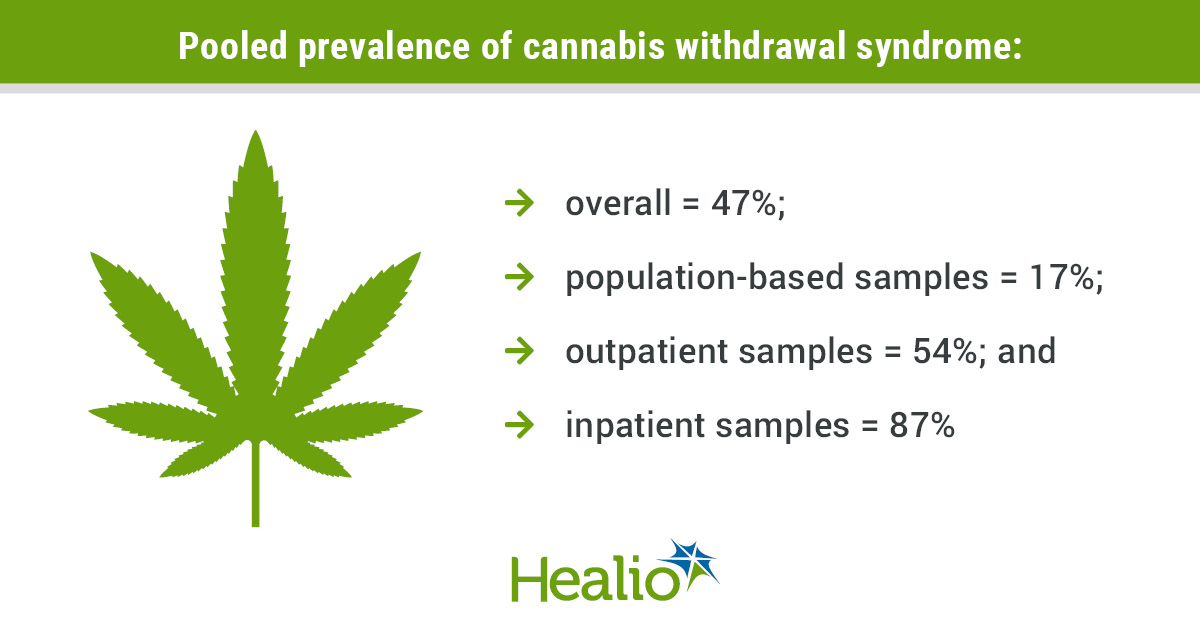Cannabis withdrawal syndrome may affect nearly 50% of regular users
Cannabis withdrawal syndrome appeared common among regular cannabis users, according to results of a systematic review and meta-analysis published in JAMA Network Open.
“Several studies using varied approaches have characterized [cannabis withdrawal syndrome], and resulting prevalence estimates have ranged from 11.1% to 94.2%,” Anees Bahji, MD, of the department of public health sciences at Queen’s University in Canada, and colleagues wrote. “Hence, although there is concern about the risks associated with cannabinoid use and [cannabis withdrawal syndrome], to our knowledge, there currently exists no comprehensive quantitative synthesis of the magnitude of risk and how elevated that risk might be relative to the general population among people with regular or problematic cannabinoid use.”
The DSM-V recognized cannabis withdrawal syndrome and defined it as the presence of at least three of seven symptoms that develop within 7 days of reduced cannabis use. These include irritability, anger or aggression; nervousness or anxiety; sleep disturbance; appetite or weight disturbance; restlessness; depressed mood; and somatic symptoms, such as abdominal pain, nausea, vomiting, headaches or sweating.
Bahji and colleagues sought to estimate cannabis withdrawal syndrome prevalence among regular or dependent users of cannabinoids, as well as to identify factors associated with this syndrome. They conducted a literature search of several databases and included articles from database inception to June 19, 2019. Eligibility criteria included articles that were published in English; reported on individuals with regular cannabinoid use or cannabis use disorder as a primary study group; reported on the prevalence of cannabis withdrawal syndrome or its symptoms using a validated instrument; reported the prevalence of cannabis withdrawal syndrome; and used an observational study design, such as cross-sectional or cohort.

The researchers identified 3,848 unique abstracts and selected 86 for full-text review. Of these, 47 studies that included 23,518 participants met all inclusion criteria. Most participants were white (72%) and men (69%), and median participant age was 29.9 years. Researchers reported an overall pooled prevalence of cannabis withdrawal syndrome of 47% (95% CI, 41-52), with significant heterogeneity between estimates (I2 = 99.2%). The researchers stratified data by source and found prevalence was 17% (95% CI, 13-21) in population-based samples, 54% (95% CI, 48-59) in outpatient samples and 87% (95% CI, 79-94) in inpatient samples, which were significantly different (P < .001). Higher cannabis withdrawal syndrome prevalence was associated with concurrent cannabis (beta = 0.005; P < .001), tobacco (beta = 0.002; P = .02) and other substance use disorders (beta = 0.003; P = .05), as well as daily cannabis use (beta = 0.004; P < .001).
“Clinicians should be aware of the high prevalence of [cannabis withdrawal syndrome] and should consider screening for [it], particularly among those who are at greater risk, in order to counsel patients and support individuals who are reducing their use of cannabis,” the researchers wrote. – by Joe Gramigna
Disclosures: Bahji reports a Canadian Institutes of Health Research Master's Student scholarship. Please see the study for all other authors’ relevant financial disclosures.
